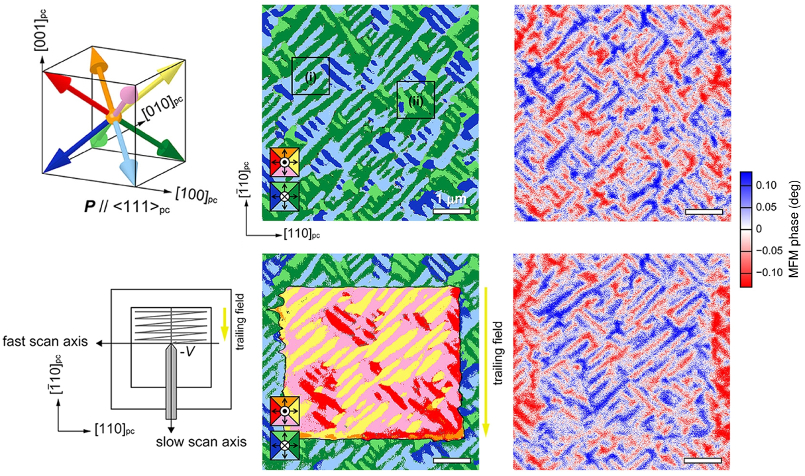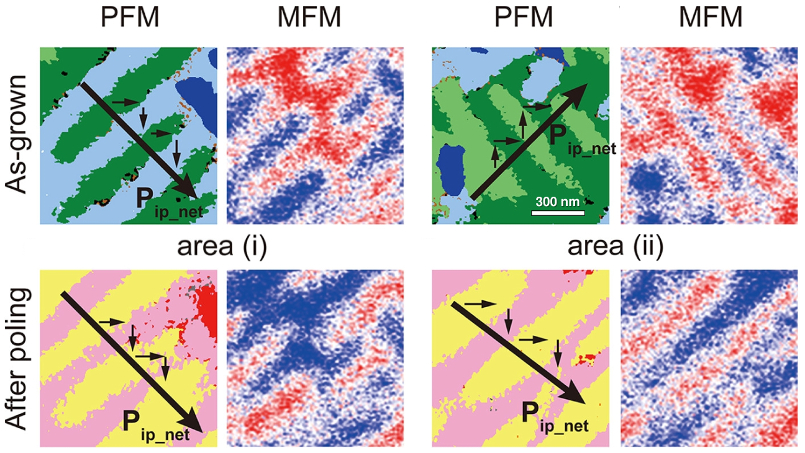AFM Systems
AFM Accessories
Learning
Contact Us
 Part of the Oxford Instruments Group
Part of the Oxford Instruments Group
Japanese researchers grew thin films of cobalt-substituted bismuth ferrite (BFCO) that exhibited spontaneous out-of-plane magnetization at room temperature. Nanoscale magnetic and electromechanical measurements confirmed that magnetization reversals could be induced in the films by electric field polarization switching.

Magnetoresistive random access memory (MRAM) and other magnetic technologies hold the potential to provide fast, high-density, long-lifetime data storage. Such devices would also consume less power if magnetization could be controlled by an electric field, without applying an electric current. However, accomplishing this concept in practice has proven elusive.
Researchers at Tokyo Institute of Technology and Nagoya Institute of Technology made progress using thin films of ferromagnetic ferroelectric BFCO. Grown on gadolinium scandium oxide (GdScO3) substrates to minimize lattice-mismatch strains, the single-phase films exhibited spontaneous out-of-plane magnetization at room temperature.
The team then used AFM magnetic and electromechanical techniques to show that the out-of-plane magnetism could be reversed simply by switching the electric field polarization P, without the need to apply current. The measurements also indicated strong coupling between ferroelectric and ferromagnetic domains.
The results open the door to MRAM and other nonvolatile magnetic memory devices with lower power consumption.

Cypher S and MFP-3D Origin+ with the PolyHeater heating stage
Piezoresponse force microscopy (PFM) images of local electromechanical response were acquired on a Cypher S AFM. The experiments were performed using Asylum’s exclusive dual amplitude resonance tracking (DART) mode for increased sensitivity to weak signals and to minimize crosstalk artifacts. The images shown represent the total or vector PFM response and were created by combining three separate images. Two images were acquired of the lateral (in-plane) PFM response at in-plane scanning angles of 0° and 90°, and a third was obtained of the vertical (out-of-plane) response.
In addition, room-temperature magnetic force microscopy (MFM) images were acquired on the Cypher S using a cantilever coated with a magnetic cobalt alloy. The images represent the phase signal for MFM experiments performed in a two-pass tapping mode approach. MFM phase images were also acquired at high temperature (150 °C) to verify that signals arose from magnetic, not electrostatic, interactions. These experiments used an MFP-3D-Origin+ AFM with a PolyHeater high-temperature sample heater. Designed for studies from ambient to 300 °C, the PolyHeater offers exquisite temperature control as well as easy sample mounting.
Citation: K. Shimizu, R. Kawabe, H. Hojo et al., Direct observation of magnetization reversal by electric field at room temperature in Co-substituted bismuth ferrite thin film. Nano Lett. 19, 1767 (2019). https://doi.org/10.1021/acs.nanolett.8b04765
Note: The data shown here are reused under fair use from the original article, which can be accessed through the article link above.
